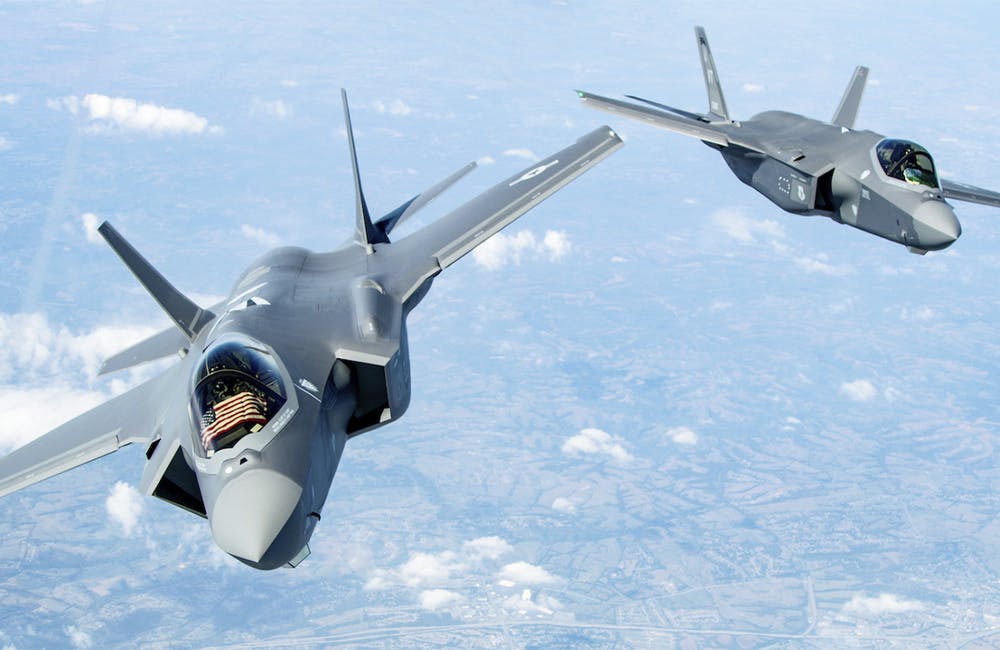Joint Navy-Air Force Simulator Expanding Digital Fighter Jet Training
A joint facility with the services wants to replicate its F-35 digital simulator technology across the Defense Department.

NATIONAL HARBOR, Maryland — A Navy facility with begin jointly training Navy and Air Force fighter pilots on the F-35 and F-22 Raptor, with potential additions for the F/A-18 Hornet and EA-18G Growler to come, officials said at the Sea-Air-Space conference Wednesday.
The Naval Air Warfare Center Aircraft Division (NAWCAD)’s Joint Simulation Environment (JSE) mimics open-air testing in a digital environment with high-fidelity models and lifelike scenarios. The Defense Department created the new facility to better replicate the dangers and complexities in real-world combat scenaries, JSE Director Blaine Summers said at Sea-Air-Space.
“When you’re engaged in high-end conflict and you’ve got an F-35 weapon system that’s feeding the operator with lots of data, that operator can’t afford to be fumbling around with a pilot-vehicle interface that isn’t the thing they trained to,” Summers said. “The buttons and knobs can’t be out of place, the data can’t be out of place, that’s all going to be second nature, so they can process it and make life-or-death. split-second decisions. That’s what this ecosystem is offering up to our warfighters.”
Summers said low-end modeling and simulation are a thing of the past and is asking industry partners to contribute to the creation of high-fidelity models that resemble everything that operators are likely to face. As the quality of the model increases, the ability to track and analyze a pilot’s mistakes in the test environment increases.
According to Summers, the performance and data created by the JSE needs to be “statistically indistinguishable” from the real world, requiring the JSE to create near-perfect representations of the threat, operational environment and even the F-35 cockpit, down to the knobs and buttons already familiar to operators.
Currently, the JSE simulates the cockpit of the F-35, but Summers said that the division is looking to bring the same value proposition to other jets like the F-22 Raptor, F/A-18 Hornet and EA-18G Growler, with the Raptor cockpits being introduced this month.
“We’re working to bring an F-22, Hornet, Growler up to other weapons systems to get them exposed to this high-fidelity threat and better understand their mission effectiveness and suitability for the highest quality,” Summers said. “Each of those … is an opportunity to partner with industry and government to bring best of breed models into the digital range to more fully prepare our weapon systems and aviators for conflict.”
The Navy and Air Force currently work together testing JSE, but Summers hopes to replicate the technology across DOD.
“It’s one thing to have a world-class capability in our backyard where we’ve got a team of engineers and software developers maintaining it. How do we productize that? How do we make it more reliable at some of these austere fleet locations that don’t have an army of engineers, that don’t have an army of software developers?” Summers said.
This is a carousel with manually rotating slides. Use Next and Previous buttons to navigate or jump to a slide with the slide dots
-

Cyber Resilience and Recovery Amid Evolving Cyber Threats
Data durability is a key aspect of NIST’s cybersecurity framework for public and private organizations.
21m listen -

Energy Researchers Aim For Holistic Approach to AI Issues
A new center at the Oak Ridge National Laboratory is looking at under-researched areas of AI to better understand how to secure it.
2m read -

How Agencies are Upskilling the Workforce in AI
Federal officials are putting in place new training and education methods to ensure its overall workforce understands the technology.
3m read -

Building Better Data Governance Across FDA
The agency is using emerging technology to tackle its data challenges.
19m listen








